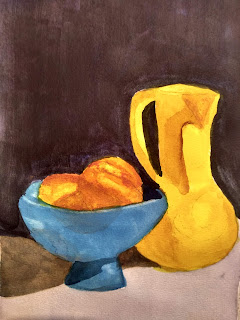Here's a bit of show and tell of student work using grisailles method in one way or another.
Barb did this picture using burnt sienna for the underpainting and following
one of the methods for creating a black background.
Jackie used color for underpaintings, and then created a misty background
that works well with the hands.
Sylvia had done this painting in sepia and pen in the past, and is
experimenting with glazing color over it.
Shirley used brown Brusho for the underpainting and
the shadows. Looks better than the photo.
Dorothy underpainted, then wanted to warm up the skin..
Working on those curls was a challenge!
Here I took the beginnings of a demo on underpainting and just
made up the rest. I underpainted with Brusho, then used several flesh tone
glazes, keeping warmer colors on the left and cooler on the right. I wanted to play with the hair,
so added greens and oranges; lifting out some highlights; and finishing with what looks like pastels, but isn't. It is a product called Intense Blocks....like Inktense colored pencils but in sticks the size of pastel sticks.
You can use them wet or dry...wet to create washes of color; dry to give a pastel look.
I added the necklace to bring the eye around instead of stopping at the hair on the left.
Inktense Blocks











